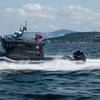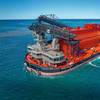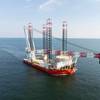Four Filipino seamen received a total of $250,000 dollars from the U.S. Department of Justice for their initiative in protecting the environment. The four informed the U.S. Coast Guard of the actions of the M/V Katerina, a ship that was found to be in violation of international and U.S. environmental laws.
U.S. Embassy Chargé Joseph Mussomeli presented the cash awards to Jonathan Sanchez, Jimmy Piamonte, Florencio Tolentino and Richard Santillan during a ceremony held today at the U.S. Embassy in the Phillippines.
The facts of the case are as follows:
1. Between February 2004 and September 2004 the M/V Katerina, a 600-foot, 16,320 ton vessel, illegally dumped large amounts of oil waste into the ocean. Large ocean-going vessels like the M/V Katerina generate waste oil and sludge from both the machinery used on board and from the fuel oil. Much of this waste accumulates at the bottom or "bilge" of the vessel.
2. These waste products that have accumulated are supposed to be run through various processes designed to separate the oil and other wastes from the water, the OWS (Oil Water Separator).
3. Once the oily water has been run through the OWS, the water can be safely discharged into the ocean and the remaining waste can be properly disposed of on shore. Large Ocean going vessels are required to maintain an Oil Record Book (ORB) to record how the ship disposes of its oil waste products.
4. U.S. and international laws authorize the U.S Coast Guard to board and inspect all vessels in United States ports to determine compliance with federal and international environmental regulations.
5. As a result of the statements given by Filipino seamen Jonathan Sanchez, Jimmy Piamonte, Florencio Tolentino and Richard Santillan, U.S. authorities learned that the captain, the owners and the engineers of M/V Katerina had violated U.S. and international environmental laws by devising an elbow pipe to bypass the OWS and discharge oily waste directly into the ocean. Engineers from the M/V Katerina also devised another pipe to discharge the sludge that had accumulated in the sludge tanks directly into the ocean, which they euphemistically labeled "the magic pipe."
6. Prior to any of the unlawful discharges, the engineers would telephone officers on the bridge, to determine whether other vessels were nearby or whether they were not too close to land, thus ensuring that the discharge could take place without risk of detection.
7. In August 2004 the Captain of the M/V Katerina received a telex from the company's headquarters in Athens reminding him that the U.S. Coast Guard in Los Angeles was very strict and that he should take steps to remove the bypass pipe and ensure that the magic pipe was properly hidden. Engineers from the M/V Katerina hid the bypass pipe underneath the floorboards and the "magic pipe" in the engine room.
8. On September 14, 2004 the vessel arrived in the Port of Long Beach, California. U.S. Coast Guard inspectors boarded the vessel. Captain Joannis Kallikis provided the Coast Guard with the ORB that falsely stated that the ship had been properly disposing of its oil waste.
9. Based on information received from the four Filipino seamen -- Jonathan Sanchez, Jimmy Piamonte, Florencio Tolentino and Richard Santillan - who reported the existence of the bypass pipe as well as its hiding place, the U.S. Coast Guard reboarded the M/V Katerina on September 15, 2004. This time, the Coast Guard found the pipe.
10. Captain Kallikis instructed the chief engineer to lie to the Coast Guard about the pipe and the chief engineer in turn instructed all the members of the engine room not to cooperate with U.S. authorities, at the risk of losing their jobs.
11. As a result of the action of the four seamen, who revealed the fraud, the U.S. Attorneys Office in Los Angeles procured guilty pleas from Captain Kallikis, Chief Engineer Eduardo Guinto, and Second Engineer Rolan Sullesta. DST Shipping, Inc. was also fined one million dollars.
12. Three of the seamen, Mr. Sanchez, Mr. Piamonte, and Mr. Tolentino initially wrote letters to the Coast Guard outlining the violations by the M/V Katerina, including a diagram that showed where the hidden pipes were stored. Subsequently they recruited the ship's cook, Mr. Santillan, who outlined further violations. They continued to assist investigators until the conclusion of the case.
Sponsored Content
Maritime leaders unite to tackle ocean plastic with launch of new alliance: the Maritime Association for Clean Seas

ABS Wavesight Advantage™: One Intelligent, Connected Maritime Platform to Transform Complexity into Operational Clarity

Subscribe for
Maritime Reporter E-News
Maritime Reporter E-News is the maritime industry's largest circulation and most authoritative ENews Service, delivered to your Email five times per week









